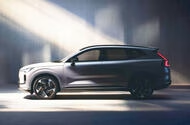Volvo is making waves in the automotive world by reviving the XC70 name for a new range-extender SUV, primarily aimed at the Chinese market. This move is part of a broader strategy to cater to the growing demand for plug-in hybrids, especially as the market for fully electric vehicles (EVs) experiences some turbulence. The XC70 is set to be unveiled soon, with a launch anticipated later this year, and it promises to bring some exciting features to the table.
What’s Special About the New XC70?
The new XC70 is being touted as Volvo’s first ‘extended-range plug-in hybrid’ (EREV), designed to offer a pure-electric range of up to 124 miles. That’s impressive—especially when you consider that it more than doubles the electric range of the current XC60 PHEV. For those who might be hesitant to fully commit to an electric vehicle, this could be a game-changer. It allows drivers to enjoy the benefits of electric driving without the anxiety of running out of charge on longer trips.
In terms of size, the XC70 is slightly larger than the XC60 and has a design reminiscent of a scaled-down XC90. However, it’s important to note that this model is built on a new architecture specifically crafted for EREVs, known as the Scalable Modular Architecture (SMA). While details on how this architecture relates to Volvo’s other platforms remain sparse, it’s clear that the company is investing heavily in this new direction.
Why the Focus on China?
China has emerged as a hotbed for EREVs, with many manufacturers pivoting to meet the local demand. Volvo’s decision to target this market first isn’t surprising, given that companies like Li Auto and Leapmotor are already making significant strides in the EREV space. The XC70’s launch follows the unveiling of the Volkswagen ID Era SUV, which also aims to capture the growing appetite for range-extending technology in China.
Volvo’s CEO, Håkan Samuelsson, emphasized that EREVs serve as a “perfect bridge to full electrification.” This is particularly relevant as the demand for pure EVs has shown signs of slowing down. By offering a robust plug-in hybrid option, Volvo can maintain a balanced product lineup while appealing to customers who may not yet be ready to transition to fully electric vehicles.
What’s Next for Volvo?
The XC70 is not just another model in Volvo’s lineup; it represents a strategic pivot as the company navigates a challenging external environment. With a significant global cost-cutting initiative underway, the XC70 is positioned to play a crucial role in Volvo’s future. The brand is committed to becoming a fully electric car company, but with only a fifth of its sales in the first quarter of 2025 projected to be electric, the XC70 offers a pragmatic solution for those still on the fence about going electric.
Interestingly, the XC70 name has been dormant since 2016, when the off-road variant of the V70 estate was discontinued. Originally branded as the V70 XC, the ‘XC’ stood for ‘Cross Country,’ and the revival of this nameplate signals a renewed focus on versatility and adventure in Volvo’s offerings.
The big takeaway? The XC70 isn’t just about reviving a name; it’s about smarter adjustments to meet evolving market demands. As Volvo continues to adapt to the shifting landscape of the automotive industry, the XC70 could very well be the vehicle that bridges the gap between traditional combustion engines and the fully electric future. Keep an eye out for its launch, as it might just redefine what we expect from plug-in hybrids.

